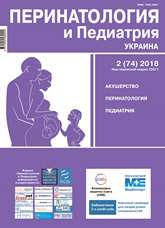Этиологическая диагностика пиелонефрита у детей и проблема резистентности микроорганизмов к антибиотикам
DOI:
https://doi.org/10.15574/PP.2018.74.73Ключевые слова:
дети, пиелонефрит, диагностика, антибиотикиАннотация
Цель — изучить этиологию острого и обострения хронического пиелонефрита у детей по результатам бактериологического исследования мочи.
Пациенты и методы. Проведен сравнительный анализ медицинских карт стационарного больного, в частности, результатов бактериологического исследования мочи у детей, больных острым и обострением хронического пиелонефрита, в возрасте от 3 до 15 лет, за период 2009–2011 гг. (n=282) и 2012–2017 гг. (n=2273).
Результаты. Выявлено уменьшение частоты положительных посевов от 45,0% в 2009–2011 гг. до 29,0% в 2012–2017 гг. Грамотрицательные и грамположительные возбудители высевались почти с одинаковой частотой за два периода наблюдения. Среди грамотрицательных возбудителей увеличилась роль в этиологии пиелонефрита Еscherichia coli от 32,5% до 43,1%, Klebsiella pneumoniaе — от 5,4% до 18,3% случав, бактерий семейства Pseudomonadaceae — 17,7%. Среди грамположительных бактерий возросла частота высева Staphylococcus aureus в развитии пиелонефрита (от 17,7% до 40,5%). Частота высева грибов рода Candida из мочи увеличилась от 2,0% в 2009–2011 гг. до 11,1% случаев в 2012–2017 гг.
Выводы. При анализе антибиотикограммы выявлен большой спектр чувствительности возбудителей к антибиотикам и относительно высокая резистентность к препаратам резерва.
Библиографические ссылки
Vakulenko LI. (2018). Etiological factors associated with the development of pyelonephritis in girls. Ukrainian Journal of Nephrology and Dialysis. 1: 38-43.
Bondarev OV, Minukhin VV, Kuzmenko AM. (2016). Antibiotic susceptibility of the main aerophilic agents of urinary tract infections in women. Teoretychna i eksperymentalna medytsyna. 1: 5-9.
Dobryk OO, Sekunda MO, Derkach IM et al. (2017). Modern approaches to the treatment of urinary tract infection in children taking into account bacterial biofilm formation. Child’s Health. 12; 4: 61-70.
Duda AK. (2017). Antibiotic resistance and the ways of its overcoming. Mystetstvo likuvannia. 3: 34-38.
Duda AK. (2017). Antibiotic resistance and the ways of its overcoming. Mystetstvo likuvannia. 6-7: 33-37.
Ivanov DD. (2011). Urinary tract infections in children. Children’s Doctor. 2: 12-15.
Kolesnyk MO, Stepanova NM, Kruhlikov VT, Rudenko AV. (2016). Etiological spectrum and a 10-year antimicrobial resistance pattern of uncomplicated urinary tract infections: (2005-2015). Ukrainian Journal of Nephrology and Dialysis. 1: 32-40
Kolesnyk MO. (2015). A national registry for patients with chronic kidney disease: 2013. Kolesnyk MO, editor. Kyiv: 202.
Samburh YaYu, Vlasenko OM, Mahdalits TI, Butikova OO. (2016). Clinical effectiveness of piperacillin/tazobactam in the treatment of infectious and inflammatory lesions of the urinary system in adults. Emergency Medicine. 8: 78-82.
Tsymbalista OL. (2017). Problem of antibiotic resistance of microorganisms. Sovremennaya pediatriya. 2: 52-56. doi 10.15574/SP.2017.82.52
Tsymbalista OL, Melnychuk LV. (2012). Pyelonephritis in children: etiological diagnosis, clinical characteristics. Archive of Clinical Medicine. 2(18): 85-88.
Churkina LN, Venerotte M, Perunova NB et al. (2017). Effect of antibiotic batumin on biofilm formation in staphylococci. Reports of the National Academy of Sciences of Ukraine. 19: 91-100.
Czaplewski L, Bax R, Clokie M et аl. (2016). Alternatives to antibities — a pipeline portfolio review. Lancet Infect Ais. 16 (2): 239—251.
Gutierrez A, Zaureti Z, Crussand S et al. (2013). B-lactam antibiotics promofe bacterial mutogenesis via an RpoS-madiated reduction in replication fidelity. Nat. Commun. 4: 1610—1623.
Grabe M, Bishop MC, Bjerklund-Johansen TE et al. (2015). Guidelines on Urological Infections. European Association of Urology: 112.
Reterson EJ, Zanzen WP, Kireev D, Singleton SF. (2012). Highthroughput scheening for RecA inhibitior using a transcreener adenosine 5I D0Ddiphosphate assay. Assay Drug. Dev. Technol. 10: 260—268.
Robinson Z, Finlay JC, Zang ME, Bortolussi R. (2014). Urinary tract infection in infants and children: Diagnosis and management. Canadion Paediatric Societ y Community Pediatrics Commitee, Infectious Diseases and Immunization Committee. Raediatr. Child Health. 19: 315—319.
Singh N, Ganadhi S, Mc Arthur E et al. (2015). Kidney fanction and the use nitrofurantion to treet urinary tract infections in older women. MAJ. 187 (9): 648—656.
Wikero S. (2014). Prevalence of uropatogenes, and wropatogenes, and molecular characterization of extended spectrum beta-lactamase producing Escherichia coli isolates in Brong-Anafo regional hospital-Sunyani. Infect. Ecol. Epidemiol. 4: 203—242.
Zai B, Zheng B, Zi Y et al. (2014). In vitro susceptibility of Escherichia coli strains isolated from urine samples obtained in mainland China to fosfomycin trometamol and other antibiotics.a 9-year surveillance study (2004—2012). BMC. Infect Dis. 14:66.
Zhang Q, Zambert G, Ziae D. еt al. (2011). Acceleration of emergence of bacterial antibiotia nesistance in connected microenoironments. Science. 333: 1764—1767.

